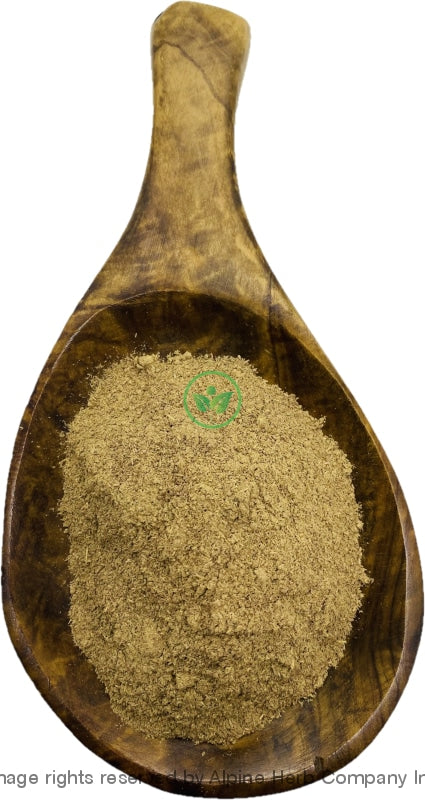Chitrak Mool Powder Alpine Herb Company Inc.
$ 8,99 $ 5,39
Botanical Name: Plumbago rosea
Common Name:
- English: Leadwort, Doctorbush
- Also, known as: Cheeta, Chitra,Chitraka, Chita, Chitavur,Chitamulamu, Agnimatha, Tellachitra, Chita, Chitu, Chitramul, Chitraka,Chitro, Chitra, Pitaro,Chittiri, Chittita, Penchitar, Kodivel,Sheetaraj, Sheetar, Chitramula, Billichitramula, Chitra,Vellakotuveri, Kotubli, Anala, Dahana, Pithi, Vahnisajnaka, Agni, Agnika, Jyothi, Nirdahana, Sikhi, Vyala, Hutasana, ceylon leadwort, doctorbush, chitrak mool – plumbago zeylanica root, Sheetraj Hindi,
Origin: India
Harvested: Wild
Parts Used: Root
General Information:
It is one of the oldest herbs which are reported to be used in Ayurveda for several disorders over thousands of years.
Plumbago rosea, commonly known as red chitrak of the family Plumbaginaceae, is a highly reputed Indian medicinal plant mentioned in Ayurvedic literature. It is a perennial shrub widely distributed in the tropics, more specifically in Southern India. The tuberous roots of the plant have been used in traditional medicine
Chitraka consists of dried mature root of Plumbago rosea, a large perennial sub-scandent shrub, found throughout India in wile state and occasionally cultivated in gardens. Leaves of Plumbago rosea are dark green in colour and are simple, elliptical with hairy margins along with alternate placement on the stem with the distance of up to 3 inches and thickness of 1.5 inches. Petioles are thin and with an approximate length of 0.5 mm and native stipules are present. Plants breed flower white in colour with diameter of 1/2 to 3/4 inch having the stalk measuring 4 to 12 inches along with a terminal raceme-type of inflorescence. Roots of Plumbago rosea are long and slightly branched with very less secondary roots, having a smooth and unbroken texture, colour of the roots is light yellow when the plant is freshly plucked out of the ground and changes to reddish brown in colour when it is dried which often initiates in the form of hard pieces. These roots are usually very strong having a bitter taste and a distinct odour with acrid.
How to use:
Powdered Herb:
There are different ways to use powdered herb.
Food Preparation: You can add powdered herb to any super food herbal smoothie, sauces, spreads and even cookies. Also for children, you can mix powdered herb with honey or glycerin to make paste. The thicker the paste, the more potent and herbal in taste. The sweet taste of honey and glycerin will help medicine go down. This method is also known as “Electuaries”.
Capsules: Encapsulating your own powdered herb at home, gives you assurance that the contents of the capsules are pure herb and no filler or any other products. These capsules can be taken with liquid.
Poultice: Poultice can be made with an herbal powder and liquid (mostly water) to form a paste which is then applied to the skin. This method is very helpful for skin conditions.
Herbal shot: Powdered herb can be mixed with water, fruit juice or other liquid to make herbal shot.
Precautions:
You should consult with a qualified healthcare practitioner before using any herbal products, particularly if you are pregnant, nursing, or on any medications.
All information on this website is for educational purpose ONLY
This information has not been evaluated by Health Canada.
This information is not intended to diagnose, treat, cure, or prevent any disease.
| Unit Size | 100g, 200g, 400g, 1kg |
|---|
Prompt shipping and expert packing
Thanks to our longstanding association with UPS FedEx DHL as well as other leading global carriers, we can offer a variety shipping options. Our warehouse staff is highly trained and will be able to pack your goods in accordance with our precise and exact specifications. Your items will go through an exhaustive examination before they will be securely packaged before being delivered. We ship to hundreds of thousands of customers daily in different countries. This is a sign of our determination to become the largest online retailer worldwide. Warehouses and distribution centers are located throughout Europe as well as in the USA.
Note that orders containing multiple items are processed according to the particular item.
We will thoroughly inspect all items ordered before shipping. Most orders are shipped within 48 hours. The delivery time will be between 3 and 7 working days.
Returns
The stock market is always changing. It's not entirely managed by us since we're involved with several entities, including the factory and the storage. Therefore, the actual inventory could fluctuate at any moment. Please be aware that it is possible that your order could be out of stock after you've placed your order.
Our policy lasts for 30 days. If it's been more than 30 days since the date you purchased your item We're sorry to say that we can't offer you a full exchange or refund.
You can only return a product if it is unused and still in the same state as when you received it. The item should be in the original packaging.
Related products
Herb Powder
Herb Powder
Herb Powder
Herb Powder
Herb Powder
Herb Powder
Herb Powder
Herb Powder
Herb Powder
Herb Powder
Herb Powder
Herb Powder
Herb Powder
Herb Powder
Herb Powder
Herb Powder
Herb Powder
Herb Powder
Herb Powder


































